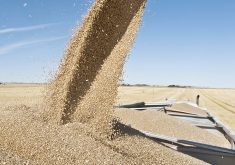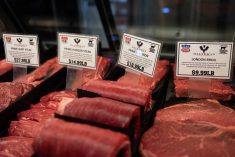Saskatchewan’s special crop producers enjoyed their most bountiful harvest last year, growing a record 4.5 million tonnes.
The harvest, roughly 300,000 tonnes larger than the previous year, marks only the second time that annual special crop production has surpassed four million tonnes.
Special crop growers also increased total acreage last year, increasing it by five percent to 6.2 million acres.
Much of the increase was due to a 700,000 acre rise in lentils, according to the 2009 Saskatchewan special crop report, which saw lentils planted on a record 2.36 million acres.
Read Also

India slaps 30 per cent import duty on yellow peas
India has imposed a 30 per cent duty on yellow pea imports with a bill of lading date on or after Nov. 1, 2025.
Lentil acreage in 2008 was estimated at 1.75 million acres.
The special crop report, released last month by Saskatchewan Agriculture, contains production and acreage figures for 14 special crops including lentils, peas, chickpeas, mustard, beans, borage and hemp.
Saskatchewan Pulse Growers executive director Garth Patterson said lentils continued to be an attractive cropping option for Saskatchewan producers last year.
Global supplies have been tighter than normal, he added, because other lentil-producing countries, including Australia, India and Turkey, have experienced production problems during the past few years.
Supply concerns abroad have translated into higher prices for Canadian growers and strong Canadian exports.
Canadian lentil exports have more than doubled in the past five years, jumping from 451,000 tonnes in 2004-05 to a record 1.03 million tonnes last year.
“Certainly in the last couple of years we’ve seen strong prices for lentils … and we’ve seen pretty stable production here as well, in large part because of the new varieties that are coming out of the Crop Development Centre,” Patterson said.
“We’re seeing new varieties come out that have better standability, (better pod height) … the yields continue to increase … and we’re getting different qualities in terms of the size and shape and colours of lentils available to growers.”
Despite a softening of prices over the past few weeks, per-acre returns for lentils still look good relative to most other crops, Patterson said.
However, an oversized crop this year could erode returns even further, he added.
Patterson said many industry analysts are anticipating a further expansion of Saskatchewan lentil acreage in 2010-11, perhaps to three million acres.
If that happens, domestic stocks will be replenished and growers should expect a further fall in prices.
Lentil supplies in Western Canada have been unusually low for the past two years.
Year-ending stocks were pegged at 51,000 tonnes on July 31, 2008, and the stocks-to-use ratio was pegged at six percent.
Twelve months later, year-ending stocks had dropped to 32,000 tonnes and the stocks-to-use ratio was estimated at three percent.
Patterson said prices generally increase when stocks-to-use ratios drop below 10 percent.
The special crops report expects year-ending stocks to be 378,000 tonnes for the 2009-10 crop year and the stocks-to-use ratio to rise to 32 percent.
“Certainly everyone is talking about a larger number of acres this spring … and I think that’s going to be the issue going ahead,” Patterson said.
“Most of the trade are looking at more than three million acres of lentils this year with most of that increase in red lentils,” he said.
“Certainly if we see a big jump in red lentil acres, that could bump that stocks-use ratio up quite a bit, which would be bearish on prices.”
Other notable trends in the special crops report include significant acreage increases in mustard, triticale and camelina.
Between 2008 and 2009, Saskatchewan’s camelina acreage jumped to 14,000 seeded acres from 5,000, triticale acreage jumped to 80,000 acres from 50,000 and mustard acreage jumped to 405,000 acres from 370,000, a year-over-year increase of 10 percent.
The 2009 specialty crop report can be found at www.agriculture.gov.sk.ca/Specialty_Crop_Report.















